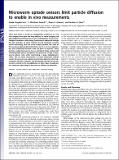Microworm optode sensors limit particle diffusion to enable in vivo measurements
Author(s)
Ozaydin-Ince, Gozde; Dubach, J. Matthew; Gleason, Karen K.; Clark, Heather A.
DownloadOzaydin-Ince-2011-Feb-Microworm optode sensors limit particle diffusion to enable in vivo measurements.pdf (774.9Kb)
PUBLISHER_POLICY
Publisher Policy
Article is made available in accordance with the publisher's policy and may be subject to US copyright law. Please refer to the publisher's site for terms of use.
Terms of use
Metadata
Show full item recordAbstract
There have been a variety of nanoparticles created for in vivo uses ranging from gene and drug delivery to tumor imaging and physiological monitoring. The use of nanoparticles to measure physiological conditions while being fluorescently addressed through the skin provides an ideal method toward minimally invasive health monitoring. Here we create unique particles that have all the necessary physical characteristics to serve as in vivo reporters, but with minimized diffusion from the point of injection. These particles, called microworms, have a cylindrical shape coated with a biocompatible porous membrane that possesses a large surface-area-to-volume ratio while maintaining a large hydrodynamic radius. We use these microworms to create fluorescent sodium sensors for use as in vivo sodium concentration detectors after subcutaneous injection. However, the microworm concept has the potential to extend to the immobilization of other types of polymers for continuous physiological detection or delivery of molecules.
Date issued
2011-02Department
Massachusetts Institute of Technology. Department of Chemical EngineeringJournal
Proceedings of the National Academy of Sciences of the United States of America
Publisher
National Academy of Sciences
Citation
Ozaydin-Ince, G. et al. “Microworm Optode Sensors Limit Particle Diffusion to Enable in Vivo Measurements.” Proceedings of the National Academy of Sciences 108.7 (2011) : 2656-2661. Copyright ©2011 by the National Academy of Sciences
Version: Final published version
ISSN
0027-8424
1091-6490